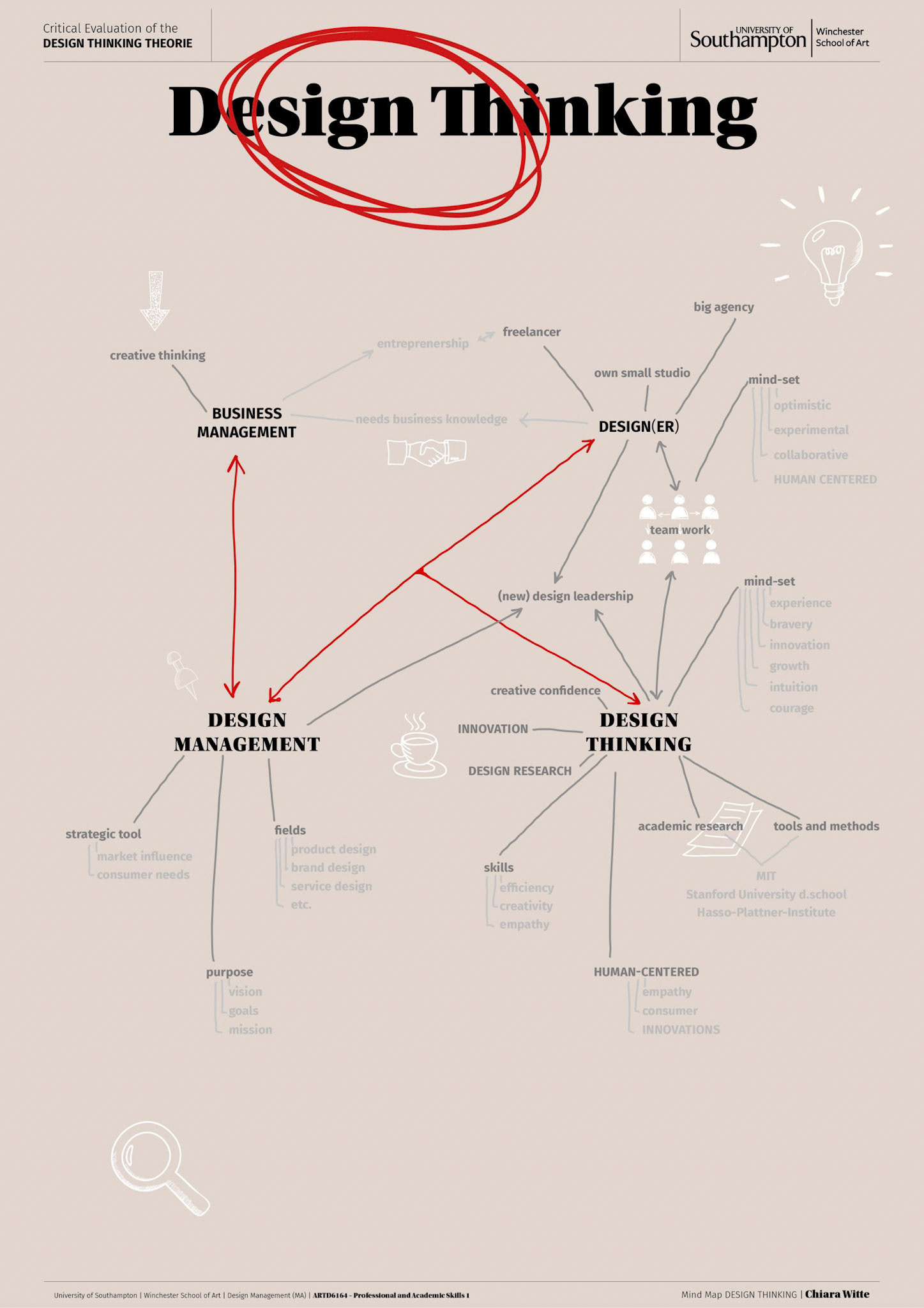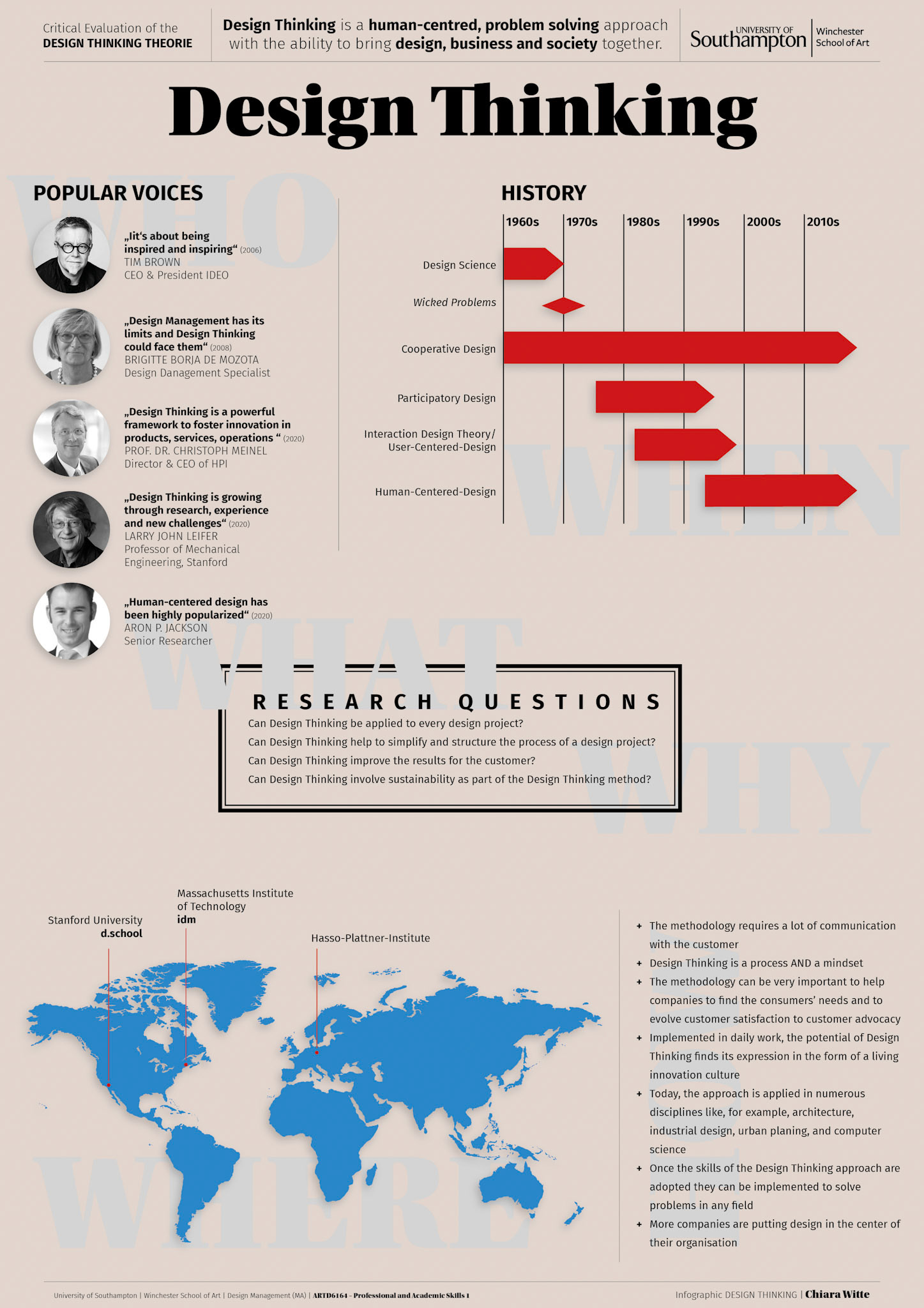Professional and Academic Skills I
University of Southampton | Winchester School of Art
Semester 1/ 2021
Critical evaluation of the DESIGN THINKING THEORIE
(excerpt)
1.1. Introduction: The Path to Design ThinkinG
To study Design Management is a conscious decision, because this field of study is not a usual discipline like for example Design or Business Management.
The first one is a mainly creative course that requires manual dexterity and the second one is more based on theories and data.
With the above mentioned program students can develop leading skills, typical for the economical education, and apply them in the creative industry (University of Southampton (UoS), n.d.).
The degree covers different disciplines such as marketing, branding, or project management (UoS, n.d.) which help to look at a creative process from a theoretical point of view.
Through working experience in different advertising agencies and in creative communication studios, the writer of this report can point out, that in the majority of the cases projects are handled without a determined structure.
There is mostly a hands-on mentally. The project staff starts right away without considering something like a standardised working method. A job is launch by sitting together and brainstorming. One team member writes down ideas, notes approaches, and defines goals. In a second phase, the project members decide which idea is the best, which way to pursue, and which goal to set.
From a professional standpoint this procedure is not satisfactory.
In the course of the studies, in lectures and in personal research the author of this text learnt about Design Thinking and introduced the theory in the assignment in Design Management Module 1.
The research question was whether the Wrapped Reichstag-project by Christo and Jeanne-Claude could be classified as a product of a DT process.
In other words, can the realisation of an art work be as structured as a marketing project?
But let’s start with the most important question: what is Design Thinking (DT)?
After the review of the relevant literature it can be concluded that no general definition for the method exists which is, subsequently, referred to as DT.
Tim Brown, CEO and president of IDEO, a global design and innovation firm, defines DT as „a discipline that uses the designer’s sensibility and methods to match people’s needs with what is technologically feasible and what a viable business strategy can convert into customer value and market opportunity“ (2008, p.2).
Later, Christoph Meinel and Larry Leifer state that "Design Thinking has been adopted and practiced by individuals and organisations in increasing numbers as a powerful framework to foster innovation in products, services, operations, and […] in the strategy and the creation of innovation cultures" (2020, p.V).
Furthermore, the two authors add that DT is growing through research, experience, and new challenges (Meinel & Leifer, 2020).
Overall, DT is a very interesting research topic because there are still many research studies ongoing although the process was developed in the late 1950s.
Education institutions like the Stanford University (d.school, USA), the MIT (sloan school & MITidm program, USA) or the Hasso-Plattner-Institute in Potsdam (Germany) work on different aspects of DT, motivating their students to rethink and redesign processes or products.
The author of this report aims to find out if there is a method
- that can be applied to every project,
- that can simplify and structure the process,
- that can improve the results for the customer.
Based on the field of study the first question to be answered is:
How can Design Thinking related to Design Management?
Subsequently a deeper analysis focuses on the issue of this paper:
Can the Design Thinking method be a game changer in a creative agency,
in other words, can creativity be systematised?

poster design by Chiara C. Witte

poster design by Chiara C. Witte
RESOURCES (excerpt)
Borja de Mozota, Brigitte// Anon., 2018. Brigitte Borja de Mozota. [Online] Available at: https://alchetron.com/Brigitte-Borja-de-Mozota [Accessed 12.05.2021].
Brown, Tim// Arthur W. Page Society, n.d. Tim Brown. [Online] Available at: https://page.org/events/2018-page-society-spring-seminar/speakers/tim-brown [Accessed 11.05.2021].
Jackson, Aaron P.// Jackson, A. P., 2020. The biggest Difference between Civilian and Military Design Thinking. [Online] Available at: https://medium.com/@aaronpjackson [Accessed 11.05.2021].
Leifer, Larry John// Anon., n.d. Stanford Profiles: Larry Leifer. [Online] Available at: https://profiles.stanford.edu/larry-leifer [Accessed 11.05.2021].
Prof. Dr. Meinel, Christoph// Hassp-Plattner-Institute, n.d. Biography of Prof. Dr. Christoph Meinel. [Online] Available at: https://hpi.de/en/meinel/chair/prof-dr-ch-meinel/biography-of-prof-dr-christoph-meinel.html [Accessed 11.05.2021.]
Brown, T., 2008. Design Thinking, s.l.: Harvard Business Review.
Meinel, C. &. Leifer L. ed., 2020. Design Thinking Research: Investigating Design Team Performance. s.l.:Springer.
University of Southampton (UoS), n.d. Design Management (MA). [Online] Available at: https://www.southampton.ac.uk/courses/design-management-masters-ma [Accessed 04.05.2021].
© Chiara C. Witte/ University of Southampton. All rights reserved.